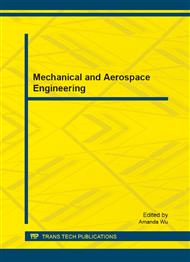p.331
p.337
p.342
p.348
p.353
p.359
p.367
p.372
p.377
Influence of Electrode Flare Angle on the Performance of Pulsed Plasma Thruster
Abstract:
In order to study the influence of electrode flare angle on the performance of Ablation Pulsed Plasma Thruster. Discharge character, plasma velocity and performance over different electrode flare angles of the Pulsed Plasma Thruster at 13.5J initial energy are measured experimentally, the effect of electrode flare angle on the electrode inductance gradient, equivalent circuit parameters and energy transfer efficiency are analyzed. It can be seen that the circuit parameters and inductance distribution are changed with electrode flare angle, the impulse bit, specific impulse, thruster efficiency and mean exhaust velocity increase non-linearly with flare angle increasing from 0 degree to 27 degree and the Pulsed Plasma Thruster gets the maximum thruster performance at 27 degree flare angle. It shows that with the increase of electrode flare angle the fraction of ablated mass accelerated magnetically and the impulse bit created by Lorentz force decrease are the reasons inducing the change in thruster performance.
Info:
Periodical:
Pages:
353-358
Citation:
Online since:
November 2012
Authors:
Price:
Сopyright:
© 2012 Trans Tech Publications Ltd. All Rights Reserved
Share:
Citation:


